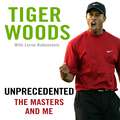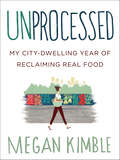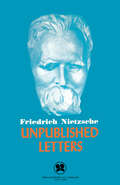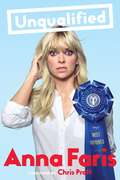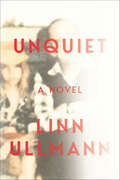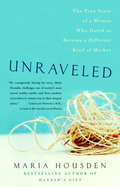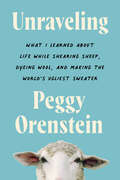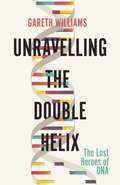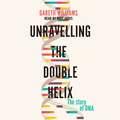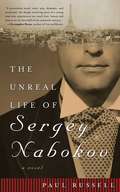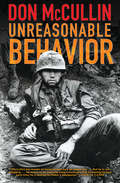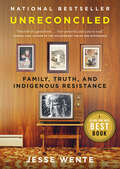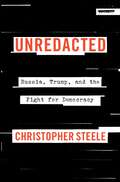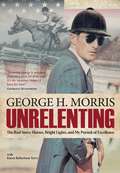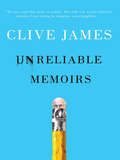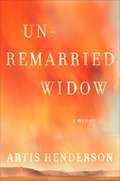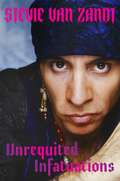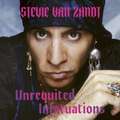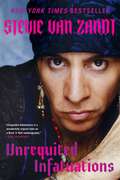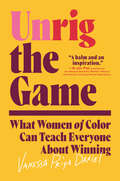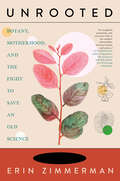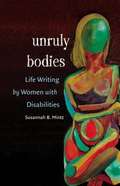- Table View
- List View
Unprecedented: The Masters and Me
by Lorne Rubenstein Tiger WoodsWINNER OF THE 2019, 2005, 2002, 2001 and 1997 MASTERS. In UNPRECEDENTED: ME AND THE MASTERS, Tiger Woods shares in his own words the story of the original Masters tournament that took him to greatness, all of which has paved the way for one of the most phenomenal comebacks in sporting history.'To come back and win the Masters after all the highs and lows is a testament to excellence, grit and determination' BARACK OBAMAIn 1997, Tiger Woods was already among the most watched and closely examined athletes in history. But it wasn't until the Masters Tournament that Tiger Woods's career would definitively change for ever. Tiger Woods, then only 21, won the Masters by a historic 12 shots, which remains the widest margin of victory in the tournament's history, making it arguably among the most seminal events in golf. He was the first African-American/Asian player to win the Masters, and this at the Augusta National Golf Club, perhaps the most exclusive club in the world, and one that had in 1990 admitted its first black member.More than twenty years after his first historic win, Tiger Woods explores his life with the game, with the Masters tournament itself, about how golf has changed over the past twenty years, and what it was like winning such an event. Woods will also open up about his relationship with father Earl Woods, dispelling previous misconceptions, and will candidly reveal many never-before-heard stories.Written by one of the game's all-time greats, this book will provide keen insight on the Masters then and now as well as on the sport itself.'Greatness like no other' SERENA WILLIAMS
Unprocessed: My City-Dwelling Year of Reclaiming Real Food
by Megan KimbleIn the tradition of Michael Pollan’s bestselling In Defense of Food comes this remarkable chronicle, from a founding editor of Edible Baja Arizona, of a young woman’s year-long journey of eating only whole, unprocessed foods—intertwined with a journalistic exploration of what “unprocessed” really means, why it matters, and how to afford it.In January of 2012, Megan Kimble was a twenty-six-year-old living in a small apartment without even a garden plot to her name. But she cared about where food came from, how it was made, and what it did to her body: so she decided to go an entire year without eating processed foods. Unprocessed is the narrative of Megan’s extraordinary year, in which she milled wheat, extracted salt from the sea, milked a goat, slaughtered a sheep, and more—all while earning an income that fell well below the federal poverty line.What makes a food processed? As Megan would soon realize, the answer to that question went far beyond cutting out snacks and sodas, and became a fascinating journey through America’s food system, past and present. She learned how wheat became white; how fresh produce was globalized and animals industrialized. But she also discovered that in daily life, as she attempted to balance her project with a normal social life—which included dating—the question of what made a food processed was inextricably tied to gender and economy, politics and money, work and play.Backed by extensive research and wide-ranging interviews—and including tips on how to ditch processed food and transition to a real-food lifestyle—Unprocessed offers provocative insights not only on the process of food, but also the processes that shape our habits, communities, and day-to-day lives.
Unpublished Letters
by Friedrich NietzscheDiscover the compelling private world of the most infamous philosopher of the nineteenth century in Unpublished Letters. Comprised of correspondence between Nietzsche's inner circle--including several titillating letters to his sister--Unpublished Letters gives readers a never-before-seen look into the philosopher's daily life.
Unpublished Letters
by Friedrich NietzscheThis collection of personal correspondence provides a rare window into the private life of the toweringnineteenth-century philosopher.Friedrich Nietzsche was the most iconoclastic philosopher of modern history. He is known to the world as the scathingly brilliant provocateur behind such foundational works as Thus Spoke Zarathustra, Beyond Good and Evil, and Twilight of the Idols. This was Nietzsche as he addressed himself to the public. But in this collection of his personal letters, we discover a very different man: Nietzsche the devoted son; the caring friend; the university student; the shy and distant lover. Comprised of correspondence between Nietzsche&’s inner circle—including several revelatory letters to his sister—Unpublished Letters gives readers a never-before-seen look into the philosopher&’s daily life.
Unqualified
by Anna Faris Chris PrattAnna Faris has advice for you. And it’s great advice, because she’s been through it all, and she wants to tell you what she’s learned. After surviving an awkward childhood (when she bribed the fastest boy in the third grade with ice cream), navigating dating and marriage in Hollywood, and building a podcast around romantic advice, Anna has plenty of lessons to share: Advocate for yourself. Know that there are wonderful people out there and that a great relationship is possible. And, finally, don’t date magicians.Her comic memoir, Unqualified, shares Anna’s candid, sympathetic, and entertaining stories of love lost and won. Part memoir—including stories about being “the short girl” in elementary school, finding and keeping female friends, and dealing with the pressures of the entertainment industry and parenthood—part humorous, unflinching advice from her hit podcast, Anna Faris Is Unqualified, the book will reveal Anna’s unique take on how to master the bizarre, chaotic, and ultimately rewarding world of love.Hilarious, honest, and useful, Unqualified is the book Anna’s fans have been waiting for.
Unquiet: A Novel
by Linn Ullmann“Didionesque.” —New York Times Book ReviewA heartbreaking and darkly funny portrait of the intricacies of family life, Unquiet is an elegy of memory and loss, identity and art, growing up and growing old.
Unraveled
by Josh BlackmanSix years after its enactment, Obamacare remains one of the most controversial, divisive, and enduring political issues in America. In this much-anticipated follow-up to his critically acclaimed Unprecedented: The Constitutional Challenge to Obamacare (2013), Professor Blackman argues that, to implement the law, President Obama has broken promises about cancelled insurance policies, exceeded the traditional bounds of executive power, and infringed on religious liberty. At the same time, conservative opponents have stopped at nothing to unravel Obamacare, including a three-week government shutdown, four Supreme Court cases, and fifty repeal votes. This legal thriller provides the definitive account of the battle to stop Obamacare from being 'woven into the fabric of America'. Unraveled is essential reading to understand the future of the Affordable Care Act in America's gridlocked government in 2016, and beyond.
Unraveled: The True Story of a Woman Who Dared to Become a Different Kind of Mother
by Maria HousdenMaria Housden tells of her own transformation, as a mother, a wife and a woman, as she struggled to cope with the death of her daughter Hannah and make the hardest decision of her life. From the author of the bestselling Hannahâ s Gift. â ¢ At the age of 36, instead of enjoying the perfect family life she had imagined as a child, Maria felt judged and found wanting by others. She realised that, no matter how much she still loved her husband and how powerful her bond of love was with her children, she had to change her life radically â " and make it her own again. So began an emotional and enlightening search for herself. â ¢ Written in the same moving, lyrical style as Hannahâ s Gift, the story unfolds in a series of painful, joyful and humorous moments, at times heart-wrenchingly sad, but ultimately uplifting.
Unraveling: What I Learned About Life While Shearing Sheep, Dyeing Wool, and Making the World's Ugliest Sweater
by Peggy Orenstein“Orenstein is such a breezy, funny writer, it’s easy to forget she’s an important thinker too.”—PeopleIn this lively, funny memoir, Peggy Orenstein sets out to make a sweater from scratch—shearing, spinning, dyeing wool—and in the process discovers how we find our deepest selves through craft. Orenstein spins a yarn that will appeal to everyone. The COVID pandemic propelled many people to change their lives in ways large and small. Some adopted puppies. Others stress-baked. Peggy Orenstein, a lifelong knitter, went just a little further. To keep herself engaged and cope with a series of seismic shifts in family life, she set out to make a garment from the ground up: learning to shear sheep, spin and dye yarn, then knitting herself a sweater.Orenstein hoped the project would help her process not just wool but her grief over the recent death of her mother and the decline of her dad, the impending departure of her college-bound daughter, and other thorny issues of aging as a woman in a culture that by turns ignores and disdains them. What she didn’t expect was a journey into some of the major issues of our time: climate anxiety, racial justice, women’s rights, the impact of technology, sustainability, and, ultimately, the meaning of home.With her wry voice, sharp intelligence, and exuberant honesty, Orenstein shares her year-long journey as daughter, wife, mother, writer, and maker—and teaches us all something about creativity and connection.
Unravelling the Double Helix: The Lost Heroes of DNA
by Gareth WilliamsDNA. The double helix; the blueprint of life; and, during the early 1950s, a baffling enigma that could win a Nobel Prize. Everyone knows that James Watson and Francis Crick discovered the double helix. In fact, they clicked into place the last piece of a huge jigsaw puzzle that other researchers had assembled over decades. Researchers like Maurice Wilkins (the 'Third Man of DNA') and Rosalind Franklin, famously demonised by Watson. Not forgetting the 'lost heroes' who fought to prove that DNA is the stuff of genes, only to be airbrushed out of history. In Unravelling the Double Helix, Professor Gareth Williams sets the record straight. He tells the story of DNA in the round, from its discovery in pus-soaked bandages in 1868 to the aftermath of Watson's best-seller The Double Helix a century later. You don't need to be a scientist to enjoy this book. It's a page-turner that unfolds like a detective story, with suspense, false leads and treachery, and a fabulous cast of noble heroes and back-stabbing villains. But beware: some of the science is dreadful, and the heroes and villains may not be the ones you expect.
Unravelling the Double Helix: The Lost Heroes of DNA
by Gareth WilliamsDNA. The double helix; the blueprint of life; and, during the early 1950s, a baffling enigma that could win a Nobel Prize. Everyone knows that James Watson and Francis Crick discovered the double helix. In fact, they clicked into place the last piece of a huge jigsaw puzzle that other researchers had assembled over decades. Researchers like Maurice Wilkins (the 'Third Man of DNA') and Rosalind Franklin, famously demonised by Watson. Not forgetting the 'lost heroes' who fought to prove that DNA is the stuff of genes, only to be airbrushed out of history. In Unravelling the Double Helix, Professor Gareth Williams sets the record straight. He tells the story of DNA in the round, from its discovery in pus-soaked bandages in 1868 to the aftermath of Watson's best-seller The Double Helix a century later. You don't need to be a scientist to enjoy this book. It's a page-turner that unfolds like a detective story, with suspense, false leads and treachery, and a fabulous cast of noble heroes and back-stabbing villains. But beware: some of the science is dreadful, and the heroes and villains may not be the ones you expect.
Unravelling the Double Helix: The Lost Heroes of DNA
by Gareth WilliamsDNA. The double helix; the blueprint of life; and, during the early 1950s, a baffling enigma that could win a Nobel Prize. Everyone knows that James Watson and Francis Crick discovered the double helix. In fact, they clicked into place the last piece of a huge jigsaw puzzle that other researchers had assembled over decades. Researchers like Maurice Wilkins (the 'Third Man of DNA') and Rosalind Franklin, famously demonised by Watson. Not forgetting the 'lost heroes' who fought to prove that DNA is the stuff of genes, only to be airbrushed out of history. In Unravelling the Double Helix, Professor Gareth Williams sets the record straight. He tells the story of DNA in the round, from its discovery in pus-soaked bandages in 1868 to the aftermath of Watson's best-seller The Double Helix a century later. You don't need to be a scientist to enjoy this book. It's a page-turner that unfolds like a detective story, with suspense, false leads and treachery, and a fabulous cast of noble heroes and back-stabbing villains. But beware: some of the science is dreadful, and the heroes and villains may not be the ones you expect.
Unreal Life of Sergey Nabokov: A Novel
by Paul RussellIn his novel based on the extraordinary life of the brother of Vladimir Nabokov, Paul Russell re-creates the rich and changing world in which Sergey, his family and friends lived; from wealth and position in pre-revolutionary Russia to the halls of Cambridge University and the Parisian salon of Gertrude Stein and Alice B. Toklas. But it is the honesty and vulnerability of Sergey, our young gay narrator, that hook the reader: his stuttering childhood in the shadow of his brilliant brother, his opium-fueled evenings with Cocteau, his troubled love life on the margins of the Ballets Russes and its legendary cast, and his isolation in war-torn Berlin.A meticulously researched novel, featuring an extraordinary cast of characters (including Picasso, Diaghilev, Stravinsky, Magnus Hirschfield, and of course the master himself, Vladimir Nabokov), this is ultimately the story of a beautiful and vulnerable boy growing into an enlightened and courageous man.
Unreasonable Behavior: An Autobiography
by Don McCullin“Unsparing reminiscences that effectively combine the bittersweet life of a world-class photojournalist with a generous selection of his haunting lifework” (Kirkus Reviews). Revised and updated after twenty-five years, Unreasonable Behavior traces the life and career of one of the top photojournalists of the twentieth century and beyond. Born in London in 1935, Don McCullin worked as a photographer’s assistant in the RAF during the Suez Crisis. His early association with a North London gang led to the first publication of his pictures. As an overseas correspondent for the Sunday Times Magazine beginning in 1966, McCullin soon became a new kind of hero, taking a generation of readers beyond the insularity of post-war domestic life through the lens of his Nikon camera. He captured the realities of war in Biafra, the Congo, Vietnam, Cambodia, and elsewhere, and the human tragedy of famine and cholera on the Bangladesh border and later, the AIDs epidemic in Sub-Saharan Africa. Already in 1968, when the Beatles wanted new press shots, they asked for Don McCullin. Harrowing and poignant, Unreasonable Behavior is an extraordinary account of a witness who survived to tell his tale and triumphed over the memories that could have destroyed him. “[Don McCullin] has been forfeit more times than he can remember, he says. But he is not bragging. Talking this way about death and risk, he seems to be implying quite consciously that by testing his luck each time, he is testing his Maker’s indulgence.” —John le Carré “McCullin handles much of the material culled from his war experiences like a seasoned thriller writer. His dialogue is convincing and sharp.” —The Observer
Unreconciled: Family, Truth, and Indigenous Resistance
by Jesse WenteA prominent Indigenous voice uncovers the lies and myths that affect relations between white and Indigenous peoples and the power of narrative to emphasize truth over comfort. <p><p> Part memoir and part manifesto, Unreconciled is a stirring call to arms to put truth over the flawed concept of reconciliation, and to build a new, respectful relationship between the nation of Canada and Indigenous peoples. <p><p> Jesse Wente remembers the exact moment he realized that he was a certain kind of Indian--a stereotypical cartoon Indian. He was playing softball as a child when the opposing team began to war-whoop when he was at bat. It was just one of many incidents that formed Wente's understanding of what it means to be a modern Indigenous person in a society still overwhelmingly colonial in its attitudes and institutions. As the child of an American father and an Anishinaabe mother, Wente grew up in Toronto with frequent visits to the reserve where his maternal relations lived. By exploring his family's history, including his grandmother's experience in residential school, and citing his own frequent incidents of racial profiling by police who'd stop him on the streets, Wente unpacks the discrepancies between his personal identity and how non-Indigenous people view him. <p><p> Wente analyzes and gives voice to the differences between Hollywood portrayals of Indigenous peoples and lived culture. Through the lens of art, pop culture, and personal stories, and with disarming humour, he links his love of baseball and movies to such issues as cultural appropriation, Indigenous representation and identity, and Indigenous narrative sovereignty. Indeed, he argues that storytelling in all its forms is one of Indigenous peoples' best weapons in the fight to reclaim their rightful place. <p><p> Wente explores and exposes the lies that Canada tells itself, unravels "the two founding nations" myth, and insists that the notion of "reconciliation" is not a realistic path forward. Peace between First Nations and the state of Canada can't be recovered through reconciliation--because no such relationship ever existed.
Unredacted: Russia, Trump, and the Fight for Democracy
by Christopher SteeleThe intelligence officer behind the explosive “Steele Dossier” steps out of the shadows, revealing a searing new report on the threat Putin and Trump pose to democracy, based on alarming intelligence exposed in these pages for the first time“Putin is now desperate to have Donald Trump back in the White House. If he succeeds in helping Trump get reelected, I am convinced that the global political order will be utterly changed. We shall have entered a new historical era of strategic chaos, a ‘new world disorder.’ The consequences of Trump winning the 2024 election are catastrophic.” –from UnredactedTo a unique degree, Christopher Steele has been an eyewitness observer of modern Russian history. He was a British diplomat and intelligence professional in Moscow when the Soviet Union was collapsing. Steele was there when the putsch against Mikhail Gorbachev took place and when Boris Yeltsin took over the newly independent Russia. After Vladimir Putin came to power, Steele rose to become one of British government’s leading Russia experts and played a central role in the investigation into the Kremlin-ordered murder of Alexander Litvinenko. Then, in 2016, he wrote a series of explosive reports about the then presidential candidate Donald Trump and his links to Russia. Now known to the world as the “Steele Dossier,” these intelligence documents drew the world’s attention to Russia’s relationship with Trump—and reluctantly thrust Steele into the center of a global maelstrom. Since Trump’s election, he has quietly continued his work. Indeed, Steele has had even better access to sources of information and intelligence on Russia—ones that have given him a privileged view of what’s going on inside the Kremlin, and how much we in the West should worry about it. In Unredacted, Steele shares for the first time what that inside view looks like, how he came to the point of gaining such a level of insight, and what Western governments—and all of us—can and should do to counter this generational threat.
Unrelenting
by George H MorrisIf there is one name in the American equestrian story that everyone knows, it is George Morris.A horse lover, rider, carouser, competitor, taskmaster, dreamer, teacher, and visionary, George Morris has been ever-present on the rarified stage of the international riding elite for most of the 70 years he's been in the saddle. He has represented our country as an athlete and a coach and, at one time or another, instructed many of our nation's best horsemen and women. His carefully chosen, perfectly enunciated words are notoriously powerful. They can raise you up or cut you to the quick. His approval can be a rainmaker; his derision can end a career.But as much as people know and respect (or, perhaps, fear) the public face of George Morris, he has lived, in other ways, a remarkably private life, keeping his own personal struggles with insecurity, with ambition, and with love behind closed doors. It is only now that he has chosen, in his own words, to share the totality of his life—the very public and the incredibly private—with the world. This engrossing autobiography, the real story of the godlike George Morris, beautifully demonstrates his ultimate humanity.
Unreliable Memoirs: Picador Classic (Unreliable Memoirs Ser. #Bk. 1)
by Clive JamesA best-selling classic around the world, Clive James's hilarious memoir has long been unavailable in the United States. Before James Frey famously fabricated his memoir, Clive James wrote a refreshingly candid book that made no claims to be accurate, precise, or entirely truthful, only to entertain. In an exercise of literary exorcism, James set out to put his childhood in Australia behind him by rendering it as part novel, part memoir. Now, nearly thirty years after it first came out in England, Unreliable Memoirs is again available to American readers and sure to attract a whole new generation that has, through his essays and poetry, come to love James's inimitable voice.
Unremarried Widow: A Memoir
by Artis Henderson“A frank, poignant memoir about an unlikely marriage, a tragic death in Iraq, and the soul-testing work of picking up the pieces” (People) in the tradition of such powerful bestsellers as Joan Didion’s The Year of Magical Thinking and Carole Radziwill’s What Remains.Artis Henderson was a free-spirited young woman with dreams of traveling the world and one day becoming a writer. Marrying a conservative Texan soldier and becoming an Army wife was never part of her plan, but when she met Miles, Artis threw caution to the wind and moved with him to a series of Army bases in dusty Southern towns, far from the exotic future of her dreams. If this was true love, she was ready to embrace it. But when Miles was training and Artis was left alone, she experienced feelings of isolation and anxiety. It did not take long for a wife’s worst fears to come true. On November 6, 2006, the Apache helicopter carrying Miles crashed in Iraq, leaving twenty-six-year-old Artis—in official military terms—an “unremarried widow.” In this memoir Artis recounts not only the unlikely love story she shared with Miles and her unfathomable recovery in the wake of his death—from the dark hours following the military notification to the first fumbling attempts at new love—but also reveals how Miles’s death mirrored her own father’s, in a plane crash that Artis survived when she was five years old and that left her own mother a young widow. Unremarried Widow is “a powerful look at mourning as a military wife….You can finish it in a day and find yourself haunted weeks later” (The New York Times Book Review).
Unrequited Infatuations: A Memoir
by Stevie Van Zandt'A wonderfully original take on a Rock and Roll autobiography' Paul McCartney'An inimitable Rock 'n' Roll life told as boldly as it was lived' Bruce SpringsteenWhat story begins in a bedroom in suburban New Jersey in the early '60s, unfolds on some of the country's largest stages, and then ranges across the globe, demonstrating over and over again how Rock and Roll has the power to change the world for the better? This story.The first true heartbeat of UNREQUITED INFATUATIONS is the moment when Stevie Van Zandt trades in his devotion to the Baptist religion for an obsession with Rock and Roll. Groups like the Beatles and the Rolling Stones created new ideas of community, creative risk, and principled rebellion. They changed him forever. While still a teenager, he met Bruce Springsteen, a like-minded outcast/true believer who became one of his most important friends and bandmates. As Miami Steve, Van Zandt anchored the E Street Band as they conquered the Rock and Roll world.And then, in the early '80s, Van Zandt stepped away from E Street to embark on his own odyssey. He refashioned himself as Little Steven, a political songwriter and performer, fell in love with Maureen Santoro who greatly expanded his artistic palette, and visited the world's hot spots as an artist/journalist to not just better understand them, but to help change them. Most famously, he masterminded the recording of "Sun City," an anti-apartheid anthem that sped the demise of South Africa's institutionalized racism and helped get Nelson Mandela out of prison.By the '90s, Van Zandt had lived at least two lives-one as a mainstream rocker, one as a hardcore activist. It was time for a third. David Chase invited Van Zandt to be a part of his new television show, the Sopranos-as Silvio Dante, he was the unconditionally loyal consiglieri who sat at the right hand of Tony Soprano (a relationship that oddly mirrored his real-life relationship with Bruce Springsteen).Underlying all of Van Zandt's various incarnations was a devotion to preserving the centrality of the arts, especially the endangered species of Rock. In the twenty-first century, Van Zandt founded a groundbreaking radio show (Underground Garage), a fiercely independent record label (Wicked Cool), and developed a curriculum to teach students of all ages through the medium of music history. He also rejoined the E Street Band for what has now been a twenty-year victory lap.UNREQUITED INFATUATIONS chronicles the twists and turns of Stevie Van Zandt's always surprising life. It is more than just the testimony of a globe-trotting nomad, more than the story of a groundbreaking activist, more than the odyssey of a spiritual seeker, and more than a master class in rock and roll (not to mention a dozen other crafts). It's the best book of its kind because it's the only book of its kind.
Unrequited Infatuations: A Memoir
by Stevie Van Zandt'A wonderfully original take on a Rock and Roll autobiography' Paul McCartney'An inimitable Rock 'n' Roll life told as boldly as it was lived' Bruce SpringsteenWhat story begins in a bedroom in suburban New Jersey in the early '60s, unfolds on some of the country's largest stages, and then ranges across the globe, demonstrating over and over again how Rock and Roll has the power to change the world for the better? This story.The first true heartbeat of UNREQUITED INFATUATIONS is the moment when Stevie Van Zandt trades in his devotion to the Baptist religion for an obsession with Rock and Roll. Groups like the Beatles and the Rolling Stones created new ideas of community, creative risk, and principled rebellion. They changed him forever. While still a teenager, he met Bruce Springsteen, a like-minded outcast/true believer who became one of his most important friends and bandmates. As Miami Steve, Van Zandt anchored the E Street Band as they conquered the Rock and Roll world.And then, in the early '80s, Van Zandt stepped away from E Street to embark on his own odyssey. He refashioned himself as Little Steven, a political songwriter and performer, fell in love with Maureen Santoro who greatly expanded his artistic palette, and visited the world's hot spots as an artist/journalist to not just better understand them, but to help change them. Most famously, he masterminded the recording of "Sun City," an anti-apartheid anthem that sped the demise of South Africa's institutionalized racism and helped get Nelson Mandela out of prison.By the '90s, Van Zandt had lived at least two lives-one as a mainstream rocker, one as a hardcore activist. It was time for a third. David Chase invited Van Zandt to be a part of his new television show, the Sopranos-as Silvio Dante, he was the unconditionally loyal consiglieri who sat at the right hand of Tony Soprano (a relationship that oddly mirrored his real-life relationship with Bruce Springsteen).Underlying all of Van Zandt's various incarnations was a devotion to preserving the centrality of the arts, especially the endangered species of Rock. In the twenty-first century, Van Zandt founded a groundbreaking radio show (Underground Garage), a fiercely independent record label (Wicked Cool), and developed a curriculum to teach students of all ages through the medium of music history. He also rejoined the E Street Band for what has now been a twenty-year victory lap.UNREQUITED INFATUATIONS chronicles the twists and turns of Stevie Van Zandt's always surprising life. It is more than just the testimony of a globe-trotting nomad, more than the story of a groundbreaking activist, more than the odyssey of a spiritual seeker, and more than a master class in rock and roll (not to mention a dozen other crafts). It's the best book of its kind because it's the only book of its kind.
Unrequited Infatuations: A Memoir
by Stevie Van ZandtUncover never-before-told stories in this epic tale of self-discovery by a Rock n Roll disciple and member of the E Street Band. <p><p> What story begins in a bedroom in suburban New Jersey in the early '60s, unfolds on some of the country's largest stages, and then ranges across the globe, demonstrating over and over again how Rock and Roll has the power to change the world for the better? This story. <p><p> The first true heartbeat of Unrequited Infatuations is the moment when Stevie Van Zandt trades in his devotion to the Baptist religion for an obsession with Rock and Roll. Groups like the Beatles and the Rolling Stones created new ideas of community, creative risk, and principled rebellion. They changed him forever. While still a teenager, he met Bruce Springsteen, a like-minded outcast/true believer who became one of his most important friends and bandmates. As Miami Steve, Van Zandt anchored the E Street Band as they conquered the Rock and Roll world. And then, in the early '80s, Van Zandt stepped away from E Street to embark on his own odyssey. He refashioned himself as Little Steven, a political songwriter and performer, fell in love with Maureen Santoro who greatly expanded his artistic palette, and visited the world’s hot spots as an artist/journalist to not just better understand them, but to help change them. Most famously, he masterminded the recording of “Sun City,” an anti-apartheid anthem that sped the demise of South Africa’s institutionalized racism and helped get Nelson Mandela out of prison. <p><p> By the '90s, Van Zandt had lived at least two lives—one as a mainstream rocker, one as a hardcore activist. It was time for a third. David Chase invited Van Zandt to be a part of his new television show, the Sopranos—as Silvio Dante, he was the unconditionally loyal consiglieri who sat at the right hand of Tony Soprano (a relationship that oddly mirrored his real-life relationship with Bruce Springsteen). Underlying all of Van Zandt's various incarnations was a devotion to preserving the centrality of the arts, especially the endangered species of Rock. <p><p> In the twenty-first century, Van Zandt founded a groundbreaking radio show (Little Steven's Underground Garage), created the first two 24/7 branded music channels on SiriusXM (Underground Garage and Outlaw Country), started a fiercely independent record label (Wicked Cool), and developed a curriculum to teach students of all ages through the medium of music history. He also rejoined the E Street Band for what has now been a twenty-year victory lap. Unrequited Infatuations chronicles the twists and turns of Stevie Van Zandt’s always surprising life. It is more than just the testimony of a globe-trotting nomad, more than the story of a groundbreaking activist, more than the odyssey of a spiritual seeker, and more than a master class in rock and roll (not to mention a dozen other crafts). It's the best book of its kind because it's the only book of its kind.
Unrig the Game: What Women of Color Can Teach Everyone About Winning
by Vanessa Priya DanielA much-needed playbook to supporting and retaining women of color in leadership roles to create lasting change in the world, from a former labor and community organizer and founder of one of the nation&’s premier funders of women of color-led organizations.&“A balm and an inspiration.&”—Ai-jen Poo, president of the National Domestic Workers Alliance and director of Caring Across Generations In the U.S., many of the most significant social justice victories of our time have been spearheaded by women of color leaders. From the streets, to the ballot box, to elected office, no other demographic group stands up more consistently and unequivocally for human rights, democracy, and the planet. Remarkably, they&’ve accomplished this despite conditions—in their fields and organizations—that make leadership uniquely treacherous for them. For women of color leaders, the game is rigged. How much more could humanity be winning if we unrigged it? What might be possible, in this clutch moment of history, with so much on the line, if movements stopped benching our best in ways that negatively impact the scoreboard for everybody? Unrig the Game equips us to support effective women of color leaders so we can all win. A former community and union organizer who started one of the largest foundations to resource women of color-led organizing, Vanessa Priya Daniel draws on candid interviews with forty-five prominent women of color movement leaders, along with her own experience at the helm of an organization, to offer an on-the-ground perspective of the obstacles leaders face, how they navigate them, and how allies can show up. Daniel highlights the unique strengths and &“superpowers&” these leaders bring to the fight for social change, while debunking the myth that identity alone makes a transformative leader.For women of color leaders, this book is a balm, a sister circle, and a master class. For everyone, it is an essential tool to realize the world we all deserve.
Unrooted: Botany, Motherhood, and the Fight to Save an Old Science
by Erin Zimmerman"Evolutionary botanist Zimmerman discusses her passion for plants and inveighs against sexism in the sciences in her marvelous debut memoir...Throughout, Zimmerman&’s enthusiasm and expertise make the science accessible even to those without a background in the subject. The results are as edifying as they are galvanizing." - Publishers Weekly STARRED Review"Erin Zimmerman has exposed a rooted gender failure in science. Her book is important not for this alone. Her work is essential for understanding the future resilience of all flora on this planet." -Diana Beresford-Kroeger, author of To Speak for the TreesAn exploration of science, motherhood, and academia, and a stirring account of a woman at a personal and professional crossroads . . .Growing up in rural Ontario, Erin Zimmerman became fascinated with plants—an obsession that led to a life in academia as a professional botanist. But as her career choices narrowed in the face of failing institutions and subtle, but ubiquitous, sexism, Zimmerman began to doubt herself.Unrooted: Botany, Motherhood, and the Fight to Save an Old Science is a scientist&’s memoir, a glimpse into the ordinary life of someone in a fascinating field. This is a memoir about plants, about looking at the world with wonder, and about what it means to be a woman in academia—an environment that pushes out mothers and those with any outside responsibilities. Zimmerman delves into her experiences as a new mom, her decision to leave her position in post-graduate research, and how she found a new way to stay in the field she loves.She also explores botany as a &“dying science&” worth fighting for. While still an undergrad, Zimmerman&’s university started the process of closing the Botany Department, a sign of waning funding for her beloved science. Still, she argues for its continuation, not only because we have at least 100,000 plant species yet to be discovered, but because an understanding of botany is crucial in the fight against climate change and biodiversity loss.Zimmerman is also a botanical illustrator and will provide 8 original illustrations for the book.
Unruly Bodies
by Susannah B. MintzA collection of essays and narratives penned by women with disabilities themselves. It appeals to students interested in women's studies, disability studies and feminist autobiography studies.
